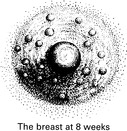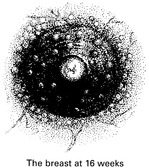An overdue menstrual period remains, for most women with a regular menstrual cycle, the first suggestion of pregnancy.
Nausea or sickness
Bladder symptoms


Breast changes
Uterine changes
PALPABLE UTERINE ENLARGEMENT
![]()
Stay updated, free articles. Join our Telegram channel

Full access? Get Clinical Tree


Diagnosis of Pregnancy
Pregnancy is the commonest cause of amenorrhoea but other causes such as disturbances in the hypothalamic–pituitary–ovarian axis or recent use of the contraceptive pill may be responsible.
Occasionally a women may continue to bleed in early pregnancy around the time of suppressed menstruation. This is usually called decidual bleeding and may, in theory, continue until about 12 weeks when the decidua capsularis fuses with the decidua vera (see Chapter 1).
Many women suffer some gastric upset in the early months of pregnancy, from nausea and anorexia to repeated vomiting, especially in the morning. The cause is unknown and raised levels of both oestrogen and human chorionic gonadotrophin (HCG) in the circulation have been blamed. Gastric motility is reduced, and in early pregnancy, the lower oesophageal sphincter is relaxed.
Increased frequency of micturition in the second and third months is due to a combination of increased vascularity and pressure from the enlarging uterus. Near term, frequency may again appear due mainly to pressure of the fetal head on the bladder.
The earliest symptoms and signs — increased vascularity and a sensation of heaviness, almost of pain — appear at 6 weeks. By 8 weeks the nipple and surrounding area — the primary areola — have become more pigmented. Montgomery’s tubercles — sebaceous glands which become more prominent as raised pink-red nodules on the areola.
By 16 weeks a clear fluid (colostrum) is secreted and may be expressed. By 20 weeks the secondary areola — a mottled effect due to further pigmentation — has become prominent.
At 7 weeks the uterus is the size of a large hen’s egg.
At 10 weeks it is the size of an orange.
At 12 weeks it is the size of a grapefruit.
